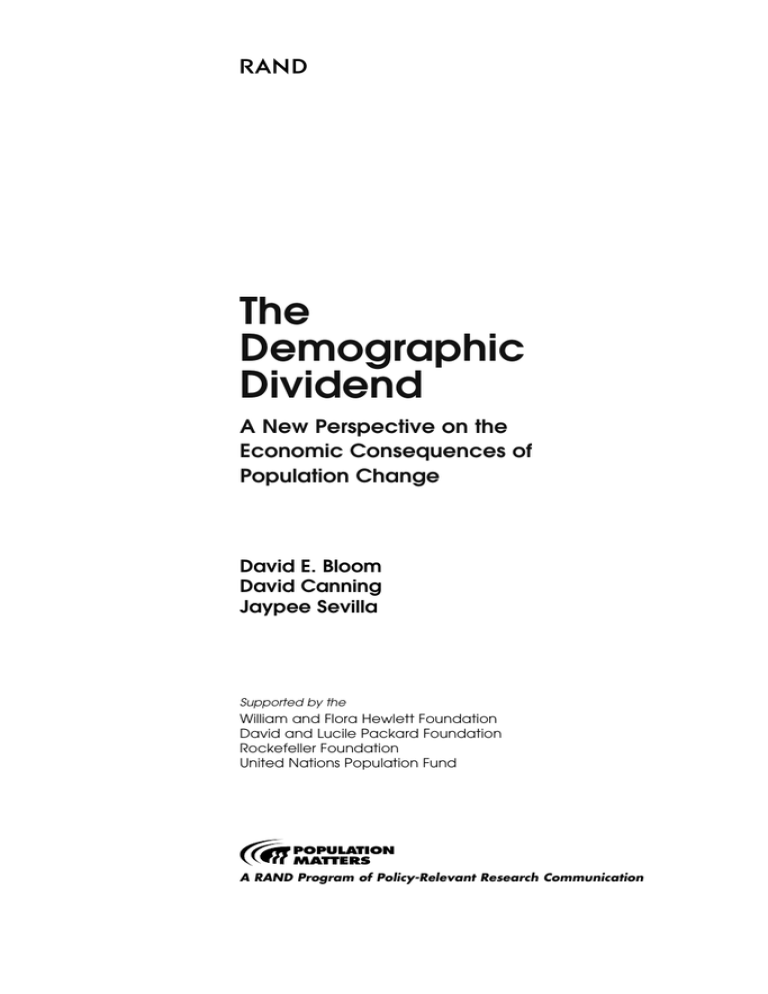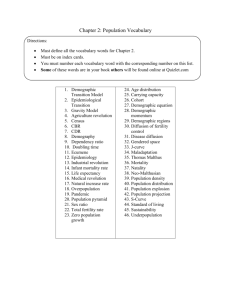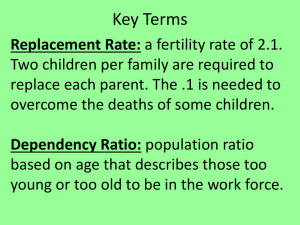
R
The
Demographic
Dividend
A New Perspective on the
Economic Consequences of
Population Change
David E. Bloom
David Canning
Jaypee Sevilla
Supported by the
William and Flora Hewlett Foundation
David and Lucile Packard Foundation
Rockefeller Foundation
United Nations Population Fund
POPULATION
MATTERS
A RAND Program of Policy-Relevant Research Communication
The research described in this report was supported by the William
and Flora Hewlett Foundation, the David and Lucile Packard
Foundation, the Rockefeller Foundation, and the United Nations
Population Fund.
Library of Congress Cataloging-in-Publication Data
Bloom, David E.
The demographic dividend : a new perspective on the economic consequences of
population change / David E. Bloom, David Canning, Jaypee Sevilla.
p. cm.
“MR-1274.”
ISBN 0-8330-2926-6
1. Demographic transition. 2. Age distribution (Demography) 3. Population. 4.
Fertility, Human. 5. Economic development. 6. Demographic transition—
Developing countries. I. Canning, David. II. Sevilla, Jaypee. III.Title.
HB887 .B58 2002
304.6'2—dc21
2002024818
RAND is a nonprofit institution that helps improve policy and
decisionmaking through research and analysis. RAND ® is a
registered trademark. RAND’s publications do not necessarily reflect
the opinions or policies of its research sponsors.
© Copyright 2003 RAND
All rights reserved. No part of this book may be reproduced in any
form by any electronic or mechanical means (including
photocopying, recording, or information storage and retrieval)
without permission in writing from RAND.
Published 2003 by RAND
1700 Main Street, P.O. Box 2138, Santa Monica, CA 90407-2138
1200 South Hayes Street, Arlington, VA 22202-5050
201 North Craig Street, Suite 202, Pittsburgh, PA 15213-1516
RAND URL: http://www.rand.org/
To order RAND documents or to obtain additional information,
contact Distribution Services: Telephone: (310) 451-7002;
Fax: (310) 451-6915; Email: order@rand.org
SUMMARY
DEMOGRAPHIC CHANGE AND ECONOMIC GROWTH:
THE IMPORTANCE OF AGE STRUCTURE
For decades, economists and social thinkers have debated the influence of population change on economic growth. Three alternative
positions define this debate: Population growth either (1) restricts,
(2) promotes, or (3) is independent of economic growth. Proponents
of each explanation can find evidence to support their cases. All of
these explanations, however, focus on population size and population growth. In recent years, however, the debate has given insufficient attention to a critical issue: the age structure of the population
(that is, the way in which the population is distributed across different age groups), which can change dramatically as fertility and mortality rates change.
Because people’s economic behavior and needs vary at different
stages of life, changes in a country’s age structure can have significant effects on its economic performance. Nations with a high proportion of children are likely to devote a high proportion of resources
to their care, which tends to depress the pace of economic growth.
By contrast, if most of a nation’s population falls within the working
ages, the added productivity of this group can produce a
“demographic dividend” of economic growth, assuming that policies
to take advantage of this are in place. In fact, the combined effect of
this large working-age population and health, family, labor, financial,
and human capital policies can effect virtuous cycles of wealth creation. And if a large proportion of a nation’s population consists of
xi
xii
The Demographic Dividend
the elderly, the effects can be similar to those of a very young population. A large share of resources is needed by a relatively less productive segment of the population, which likewise can inhibit economic growth.
After tracing the history of theories of the effects of population
growth, this report reviews evidence on the relevance of changes in
age structure for economic growth. It also examines the relationship
between population change and economic development in particular
regions of the world: East Asia; Japan; North America, Western
Europe, Australia, and New Zealand; South Central and Southeast
Asia; Latin America; the Middle East and North Africa; sub-Saharan
Africa; and Eastern Europe and the former Soviet Union. Finally, it
discusses the key policy variables that, combined with reduced fertility and increases in the working-age population, have contributed
to economic growth in some areas of the developing world.1
THE DEMOGRAPHIC TRANSITION AND THE
“DEMOGRAPHIC DIVIDEND”
The relationship between population change and economic growth
has taken on added salience in recent years because of demographic
trends in the developing world. At varying rates and times since
World War II, developing countries have been undergoing a demographic transition, from high to low rates of mortality and fertility.
This transition is producing a “boom” generation—a generation that
is larger than those immediately before and after it—that is gradually
working its way through nations’ age structures. The East Asian nations were at the forefront of this transition; other regions, including
Latin America, began their transitions later, in the 1960s and ’70s. Yet
______________
1 The text, tables, and figures for this paper draw heavily on data from a recent CD-
ROM published by the United Nations (United Nations, 2001). Unless otherwise
noted, we use the UN’s “medium variant” for all data. The UN’s methodology has
been criticized for its reliance on the assumption that all countries will converge to a
fertility rate of 2.1 children per woman. The concern here is that this suggests fertility
will rise in quite a few countries where the total fertility rate is currently below the replacement level of 2.1. Regardless of the merits of this critique, we note that most of
the results presented in this paper are qualitatively insensitive to the difference between the “medium-” and “low-fertility” variants of the data.
Summary xiii
other areas—notably some countries in the Middle East and Africa—
have not yet fully begun, or are in the early phases of this transition.
THE ESSENTIAL POLICY ENVIRONMENT
Nations undergoing this transition have an opportunity to capitalize
on the demographic dividend offered by the maturing of formerly
young populations. The demographic dividend is not, however, automatic. Given the right kind of policy environment, this demographic dividend can help to produce a sustained period of economic growth, as it did in several East Asian economies. The critical
policy areas include
•
public health
•
family planning
•
education
•
economic policies that promote labor-market flexibility,
openness to trade, and savings
Policymakers in developing countries have a window of opportunity
for exploiting the maturation of previously young populations.
Policymakers should consider how to maximize and capture this
dividend by accelerating the demographic transition, and allowing
extra labor to be absorbed productively in the market. Finally, policymakers must plan for the future health care and pension-income
needs of this baby-boom generation when it ages. The demographic
transition offers policymakers a window of opportunity. Seizing it
could prove vital to the economic and social development of their
countries.
Note that policies that enhance the free operation of markets are frequently referred to throughout the report. In most simple economic
models, such policies will tend to promote a country’s ability to take
advantage of the demographic dividend. However, two caveats are in
order.
First, policy reforms that make labor markets more flexible are not
unambiguously beneficial, especially in the short run. Political feasibility can also be an issue. Although social protection programs
can, in principle, ease the impact of labor market reforms, workers
xiv
The Demographic Dividend
who suffer pay reductions, who are displaced, or who fear these outcomes can be a potent political force resisting change. Furthermore,
capture of the potential demographic dividend can be impeded by
labor market rigidities that pervade many developing countries.
These include rules governing the hiring and firing of individuals that
prevent employers from taking risks and thus deter investment;
minimum wages that exceed market rates and thereby discourage
hiring and training; government pay practices that are grossly out of
line with the market; and labor market inertia caused by labormanagement bargaining.
Second, similar issues arise with respect to free trade, since it is well
established that trade liberalization creates both winners and losers.
Openness to trade can provoke economic adjustments that lead to
unemployment and poverty. There are also some important issues
about the fundamental fairness of outcomes that result when countries become more integrated into the world economy. These questions relate, for example, to intellectual property rights, immigration
restrictions, and developed country protectionism.
Devising economically and politically realistic programs to deal with
these challenges is hugely important, though beyond the scope of
this report.





